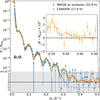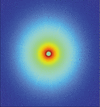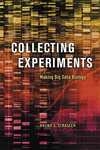issue contents
February 2022 issue

Cover illustration: Bellisario et al. [J. Appl. Cryst. (2022), 55, 122–132] introduce a neural network for coherent X-ray diffractive imaging experiments that can restore noisy and masked simulated diffraction intensities from biological macromolecules.
research papers
The development and characterization are described of a co-flow injector for liquid-jet crystal delivery applied for serial crystallography with X-ray free-electron lasers.
Open  access
access
 access
accessA method is reported to determine the phase and amplitude of sinusoidally modulated event rates, binned into four bins per oscillation, based on data generated at the resonant neutron spin-echo spectrometer RESEDA at FRM-II.
A novel method enabling 3D non-destructive strain mapping on the grain scale using laboratory X-ray diffraction contrast tomography is presented and validated using simulated data.
Open  access
access
 access
accessA method is presented to reconstruct the parent body-centred cubic microstructure from the child hexagonal close-packed microstructure in zirconium alloys. This is used to provide post-processing of the microstructure to understand structural units in the material.
Powder X-ray diffraction with Rietveld analysis was used for quantitative assessment and characterization of the crystalline composition of urinary tract calculi. Refined unit-cell parameters and crystallite size data for crystalline phases were generated.
A liquid cell design with low inelastic and incoherent elastic neutron scattering background is realized. Using this cell design with the new high-flux CANDOR neutron reflectometer, practical measurement of the neutron reflectivity from a thin film bathed by a fluid reservoir at the 10−8 level is demonstrated.
Open  access
access
 access
accessA double-walled sapphire single-crystal gas-pressure cell (type III) for in situ neutron diffraction
A new sapphire single-crystal gas-pressure cell for elastic neutron scattering to study solid–gas reactions is presented and evaluated; it allows conditions of 298 K and 9.5 MPa hydrogen pressure and 1110 K at ambient pressure.
Download citation


Download citation


The atomic model of a new ϕ phase of Au–Cu–Cr was determined using powder X-ray diffraction and verified by similarity to the known ζ phase. The similarity was assessed using a `strong-reflections approach' based on analysis of electron diffraction patterns.
CCDC reference: 2121302
A laboratory diffractometer for time-resolved high-resolution X-ray diffraction studies of reversible and irreversible processes in crystalline materials is presented.
The linear Larmor phase aberration of modulation of intensity emerging from zero effort (MIEZE), introduced by the transverse size of the sample, can be corrected by using two magnetic Wollaston prisms.
Open  access
access
 access
accessThe new technical features and improved performance of the time-resolved ultra-small-angle X-ray scattering beamline at the ESRF are presented. The beamline enables static and time-resolved investigations from ångström to micrometre size scales down to the sub-millisecond time range and coherent scattering studies in the ultra-small-angle region. Among the main applications are the elucidation of static and transient hierarchical structures in soft matter and biophysical systems, and the dynamics of out-of-equilibrium complex fluids.
This work demonstrates the feasibility of using dark-field X-ray microscopy to image phonon wavepackets at the picosecond time scale, with an X-ray free-electron laser source and a pump–probe scheme. Taking the specifications of the XCS instrument at the Linac Coherent Light Source as an example, simulations show the propagation of a strain wave with a clear contrast and intensity.
Open  access
access
 access
accessA neural network for coherent X-ray diffractive imaging experiments is presented that can restore noisy and masked simulated diffraction intensities from biological macromolecules.
Download citation


Download citation


Open  access
access
 access
accessAtomistic structure models of nanocrystalline calcium silicate hydrate [C-(A)-S-H] that account for nanostructural features such as isolated layers, turbostratic disorder and fibrils are obtained via a supercell approach using TOPAS. Quantitative X-ray diffraction of C-(A)-S-H is demonstrated for autoclaved aerated concrete and intermediates.
CCDC reference: 2124994
teaching and education
Open  access
access
 access
accessTangible symmetry elements and space-group models to guide from molecular to solid-state composition
Large and robust models of the most abundant space groups and symmetry elements are presented as an aid to visualization. In this way, space-group symmetry can be introduced to any audience in a readily understandable manner.
Free 

The design and manufacture of an automated scale model of a four-circle single-crystal X-ray diffractometer is presented.
Open  access
access
 access
accessThe concept of the Euler characteristic as a property of space-filling polyhedra in crystallography is discussed in a didactic way; a number of other aspects, all of fundamental importance in mathematics, are covered. A game is designed to allow the readers to absorb the concept of the Euler characteristic in an entertaining way.
Open  access
access
 access
accessA simple experiment to explore and illustrate Bragg diffraction and reciprocal space using a laser pointer and Au microdisc arrays is demonstrated. The flexibility of the array design allows the demonstration of basic concepts such as lattice and atomic form factor, but also more advanced ones such as quasicrystal and shape function.
Free 

This work details a set of newly made and maintained 3D models for the purpose of teaching crystallography. These models are all freely downloadable and viewable online through Sketchfab.
computer programs
Open  access
access
 access
accessA versatile generic framework for parent grain reconstruction from fully or partially transformed child microstructures has been integrated into the open-source crystallographic toolbox MTEX. The framework extends traditional parent grain reconstruction, phase transformation and variant analysis to all parent–child crystal symmetry combinations and allows the programmatic creation of individual workflows to reconstruct parent grains.
Data processing and analysis tools are presented that are suitable for the large data sets generated from in situ small-angle X-ray scattering experiments.
A new algorithm has been devised and coded in a DigitalMicrograph package to reduce an arbitrary three-dimensional primitive cell to the standard Niggli cell and further convert to the Bravais-type lattice. Superior numerical stability and robustness for tolerating large uncertainties in the experimental input cell are demonstrated and discussed.
book reviews
Free 



 journal menu
journal menu










































